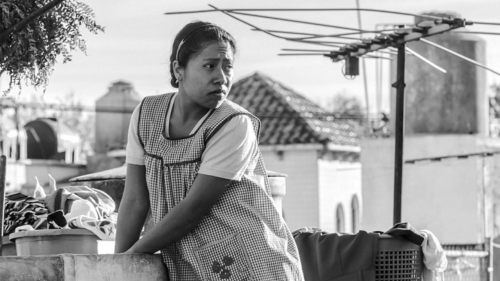Fragile Existence In The Films Of Alfonso Cuarón
“Don’t go in the water” a mother, Sofia (Marina de Tavira), tells her children in Alfonso Cuarón’s Roma. The family is on a beach holiday and mom leaves their nanny/housekeeper, Cleo (Yalitza Aparicio), in charge while she grabs the car. The noise of the waves is already so loud that it sounds more like a wood chipper ready to pulp. What follows is stressful; children near water always triggers anxiety. When the kids go under and Cleo has to go in after them, it’s completely in line with Cuarón’s style of harrowing filmmaking where life is on a tightrope.
Roma continues Cuarón’s exploration of the miracle of our existence that flows through Children of Men, Harry Potter and the Prisoner of Azkaban and Gravity. The story is centered on a family living in Mexico City in the 1970s and it’s based on Cuarón’s childhood. The film is a tribute to Cuarón’s real-life nanny, Liboria “Libo” Rodríguez, an indigenous Mixtec woman who joined their family as a caretaker when the director was a baby, and is still part of his life as an adult.
For years Cuarón had tried to turn his childhood into a script in order to better understand the past, especially his absent father. These themes of missing parental figures shone through in Cuarón’s adaptation of Great Expectations, A Little Princess, the coming-of-age vibes of Y Tu Mamá También and Harry Potter yearning for a familial compass in Prisoner of Azkaban.
In an interview with Variety Cuarón said, “I think I wanted to understand, to put the pieces together. [Jorge Luis] Borges talks about how memory is an opaque, shattered mirror, but I see it more as a crack in the wall. The crack is whatever pain happened in the past. We tend to put several coats of paint over it, trying to cover that crack. But it’s still there.”
In Roma, Cuarón throws his entire heart up on screen and traces the cracks of his past with great clarity. Working as his own cinematographer, Cuarón shot the film in black and white and it feels like you’re watching his memories. The world is always threatening to tear the family apart and love is what keeps them together. As corny as that sounds, Cuarón has achieved a feat reminiscent of the films of Frank Capra - authentic but not sentimental and never afraid to face dark realities. People forget the plot of It’s a Wonderful Life is triggered by a man contemplating suicide. Roma features a hospital sequence that’s as emotionally nerve-racking as anything in Cuarón’s previous films but it’s a heartbreaking fact of life that happens to women daily. As in Children of Men, the gift of new life and the cruelty of the human body's limitations are evocative in Roma and it highlights how lucky we are to be here.
The chaos of life in Roma is similar to the way nature is trying to slay the astronauts in Gravity and the explosive paranoia of a world about to self-destruct in Children of Men. During a New Year’s Eve party at a mansion in Roma, a fire breaks out in a forest and caretakers rush to put it out while party guests sip cocktails on the edge of the blaze in defiance of the flames’ attempt to ruin a good time. Cuarón does let Roma breathe a little in the spaces between the turmoil to appreciate the life of Cleo, a woman, who must cope with her own problems while anchoring the lives of a crumbling family unit. Cleo is not only asked to care for five people, but provide them with strength and assurance that is often expressed in unspoken ways. A lot of the time, Cleo’s presence is what’s best for the family, but she’s never portrayed like Mary Poppins. Instead of following each family member (the norm for films centered on domestic life) Cuarón keeps the camera focused on Cleo as she goes about her day. It’s a wonderful proof of life for Cleo as the avatar for Libo.
The beauty of life in Cuarón’s films is endurance. Against the odds and all the things trying to destroy us: you are here, and you are loved.



